There are different methods of casting. These include pressure die casting, gravity die casting, investment casting, sand casting, centrifugal casting, vacuum die casting, lost foam casting, continuous casting, and low-pressure casting.
In this article, I will explain each of these types of casting. Follow closely.
The types of casting
Pressure die casting
Die casting involves heating metal in a furnace till it turns molten. After, pour the molten metal into the mold. Allow it to cool off.
After cooling off, the metal would retain the shape of the mold’s inner cavity and you can then remove it for further processing. Die-cast parts are exceptionally accurate and require minimal machining.
The process of die casting
• The first step to manufacture aluminium die-cast parts is to prepare the mold. The mold is known as the tooling. The mold contains the mold cavity and allows bulk production of aluminium die-cast parts.
The mold design determines the dimensions and contours of the casting. It affects the configuration, shape, uniformity and quality of the castings.

So, before preparing the mold, you should consider the dimensions and geometry of the castings you want to manufacture. You should calculate the mold’s design according to the size of the casting.
• Incorporate the gating system to the mold. The gating system is the channel through which the molten metal flows to the die cavity. It allows seamless flow of molten metal from the ladle to the mold cavity.
The various types of gating systems include horizontal, vertical, top gating, middle gating and bottom gating systems. The gating system contains the sprue, runner, sprue well, the pouring basin and the ingate.
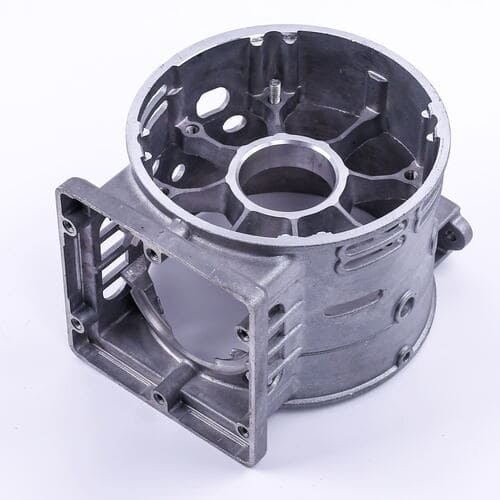
• Using the die casting machine, inject the molten metal into the mold. There are two types of die casting machines. These are the hot chamber die casting machine and cold chamber die casting machine.
• Allow the molten metal to solidify in the mold.
• After solidification, you can now remove the die casts from the machine. Thereafter, you need to apply the lubricant again on the internal surface before clamping the die together
• You can conduct CNC machining on the die-cast parts. This will give the castings smoother surface.

• Remove excess scrap metal from the casting as it continues to cool off. Cut off sharp edges and excess materials
• Apply surface treatment to the cast parts. This is the last stage of die casting. The various surface treatment options you can use include: powder coating, chemical film, anodising, etc.
Gravity die casting
This is a permanent mold casting process. It involves pouring molten metal from a crucible into a mold under the force of gravity. This process depends on gravity to fill the mold. It does not involve pressure.
After cooling off, the metal would retain the shape of the mold’s inner cavity. You can then remove it for further processing.
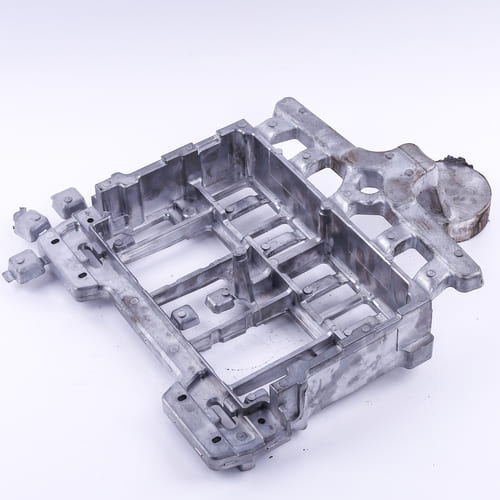
The process of gravity die casting
The production processes of gravity die casting is similar to that of pressure die casting. The difference between them is how molten metal is applied into the mold. Gravity die casting does not involve pressure or any other force. It only uses gravitation.
So, the process includes:
• Pour the molten metal into the mold from above using a ladle or vessel. The molten metal fills from the bottom up, only under gravitational force. No other force is used.
You will pour the molten metal into the runners with minimum turbulence. This is to reduce oxidation, foaming, porosity and inclusions. Sometimes, you may have to tilt the die to control the pouring.

The runners will then convey the metal to different parts of the cavity and allow it to properly fill the voids. The molten metal enters the mold at a slow pace.
The exact time the molds will be filled depends on certain factors. These factors include the geometry of the die-cast parts, the thermal conductivity of the material and the mold, the filed rate of the alloy and the gate area.
Gravity casting depends on gravity to fill the mold. So, the production process may not be faster like some other casting methods such as pressure die casting.

You can use both metal and sand cores to create internal voids. With sand cores, you can incorporate cavities and undercuts into the die castings.
Note that there are two types of gravity die casting machines. These are automatic and manual machines. For small-scale castings, you can use the manual machine. You will pour the molten metal by hand. However, for large-scale castings, you can use the automatic machine to pour molten metal into the mold.

• Solidification
• Removal of the casting
• Trimming. As the casting cools off, remove excess scrap metal. Cut off sharp edges and excess materials
• CNC machining. This is to give the castings smoother surface.
• Finishing. The various surface treatment options you can use include: powder coating, chemical film, anodizing, etc.
Investment casting
It is a process of making accurate, small refractory alloys using molds formed around a pattern of wax or other similar materials. This is then removed by melting.

The process of investment casting
• Create a pattern of the casting. Investment casting uses pattern. The pattern determines the shape and geometry of the casting. The pattern is usually made of wax.
• Assemble the wax with other compounds to form the metal delivery system, which includes the gate and runner. Mount the wax patterns and create the tree.

• At this point, create the mold shell. Dip the whole wax pattern and assemble it into a ceramic slurry. Cover it with sand stucco and allow it to dry. Repeat this process until you create a shell with the desired thickness.
After the ceramic shell is fully dry, it becomes strong enough to retain the molten metal during casting.
• Remove the wax. Place the entire wax assembly in a steam autoclave. This is to melt away most of the wax pattern and gating material
Burn the remaining wax in the ceramic materials out in a furnace. This will increase the stability and strength of the ceramic material. It also increases the reaction of the shell and metal during casting.

This process will produce just the ceramic mold with the cavity. Note that the mold has no parting line.
• Pre-heat the mold to the necessary temperature and fill with molten metal. Allow it to solidify.
• After solidification, break the mold shell away from the casting. Also, cut off the gates and the runner from the casting.
• Conduct CNC machining on the cast parts. This is to give the parts a smoother surface. You can also perform surface treatments such as chemical film, anodizing, etc on the parts.
Advantages of investment casting
• You can use it to create cast parts with intricate designs and repetitive close tolerances.
• Its cast parts have net shape or near-net-shape. This reduces post-cast processing costs.
• You can use it to manufacture castings that weigh more than 1,000 pounds.
• Investment castings have standard and fine finishings. The castings also have high dimensional accuracy.
Disadvantages of investment casting
• The tooling costs is high and not suitable for small-scale casting.
• Investment castings are difficult to cast if they require cores.
Sand casting
For this casting, you will pour liquid metal into a sand mold containing hollow cavity of the desired shape. The mold used here is made of compressed or compacted sand. After solidification, remove the cast parts and conduct post-processing finishing.
Process of sand casting
• Create the pattern for the casting. The process involves a reusable pattern with the same details as the desired finished part. However, give an allowance for shrinkage.
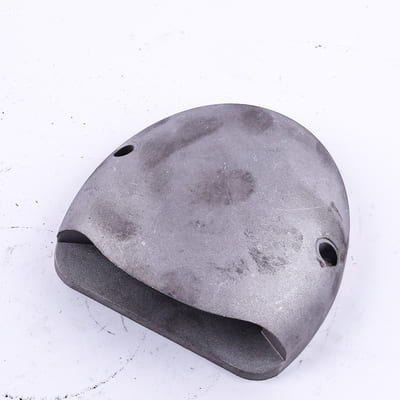
The pattern can be made of different materials such as metal, synthetics, expanded polystyrene, etc. The pattern should contain metal delivery system such as gates and risers.
• At this point, create the mold. You can do this by forming sand material around the pattern. There are various sand materials you can use. Silica is a commonly used sand. The sand material should be strong enough to hold the weight of the molten metal during casting.
Alternatively, you can create the mold by machining the desired shaped cavity directly into a block of sand. This method is suitable during product development as you can easily implement design changes.

• The mold usually contain two pieces. These are the top half and the bottom half. After the sand has set, separate the halves and remove the pattern.
To get a better surface finishing, add a refractory coating to the mold. Place the halves together to get a cavity in the shape of the pattern.
• Pour the molten metal into the mold. The mold’s cavity will determine the shape of the casting. Allow the casting to solidify.
• After solidification, remove the casting from the mold.

• Cut off the gates, risers and runners in the castings. Conduct CNC machining to give the parts smoother surfaces.
• Conduct post-processing finishing on the cast parts to get finer and smoother parts. The various surface treatments include anodizing, powder coating, etc.
Advantages of Sand casting
• You can use it to produce large parts.
• It can produce castings with complex designs and intricate shapes.
• The tooling and equipment costs are low.
• It has a fast production cycle.
• The scraps in sand casting are recyclable.
Disadvantages of sand casting
• Sand cast parts usually have poor surface finishing and tolerance. The parts always require secondary machining.
• It is not suitable for large-scale productions as it has a low production rate.
• Sand cast parts have low material strength.
Centrifugal casting
Here, you will pour molten metal into a rapidly spinning cylindrical mold. The centrifugal force from the rotation exerts pressure on the molten metal.
This distributes the molten metal to the outer regions of the circular mold cavity. After solidification, remove the castings from the mold.

The process of centrifugal casting
• Pour molten metal into a pre-heated spinning mold. This can either be on a horizontal or vertical axis. The axis depends on the configuration of the cast parts you want to make.
• By pouring molten metal on a spinning mold, centrifugal force distributes the molten metal in the mold. It does this at a pressure that is 100 times higher than the force of gravity. As the mold begins to fill, the more dense molten metal is forced to the wall of the spinning die.
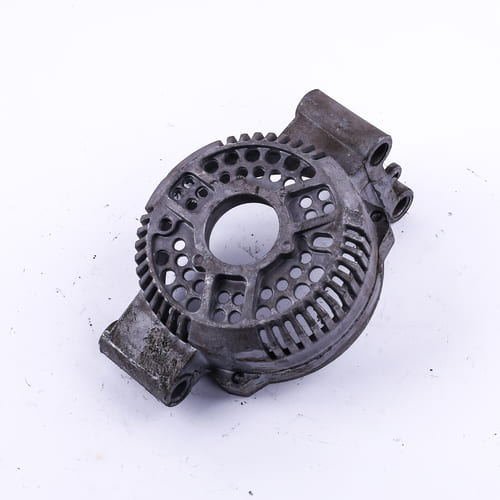
• Allow the casting to solidify.
• After solidification, remove the casting from the front of the mold.
• Conduct the CNC machining on the cast parts. You can also conduct surface treatment on the parts.
Advantages of centrifugal casting
• The castings have high dimensional integrity. It is also suitable to achieve a uniform grain structure in casting.
• It can manufacture large parts, up to 135,000 lbs/61, 350kg or more.
• Cast parts made with centrifugal casting do not have defects such as shrinkage cavity, gas pocket, blowholes, etc.
• Impurities in the castings can be removed easily. This is because collection of impurities is at the centre of the mold.
Disadvantages of centrifugal casting.
• The tooling costs is high
• It can only produce fewer shapes.
• Also, not all alloys can be cast with this method.
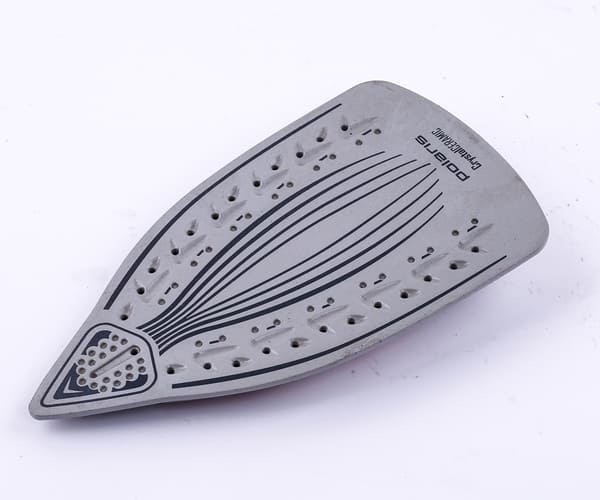
Vacuum die casting
Vacuum die casting involves injecting molten metal into the mold, and then allowing it to solidify before ejection. While injecting the molten metal, you have to use a pump to create a vacuum in the mold.
You will use a vacuum valve or pump to discharge gas in the mold cavity and shot sleeve. This is to avoid air inclusion in the castings.
This type of casting is usually used when air entrapment is a problem with the mold. Air entrapment can cause defects such as porosity, blisters, etc in the cast parts.
Advantages of vacuum die casting
• This process significantly reduces gas porosity in the cast parts. This improves the tensile strength and density of the cast parts.

• You can use it to cast more precise and thinker parts. This is because the negative pressure in the cavity makes the molten metal reach all the recesses.
• Vacuum die cast parts have high mechanical strength. They also have excellent surface finishing. So, the parts require little post-production operations.
• In vacuum casting, there is no gas pores and the parts can be heat treated and welded.
Lost foam casting
This is a process of die casting in which molten metal evaporates a foam mold being held still with sand. It is a relatively modern method of casting.
The process of Lost foam casting
• It involves using a foam pattern. A foam pattern is made with expanded polystyrene. Add the gating system to the pattern to form a cluster.

• Coat the cluster with a permeable refractory slurry, usually by dipping. Once it dries, the refractory coating forms a hard shell around the foam pattern.
• You can now place the cluster in a foundry flask or box. Surround it with loose, un-bounded sand which is then vibrated to aid compaction.
• Pour the molten metal into the mold cavity.
• After pouring the metal into the mold, the foam pattern will vaporise immediately. The metal will fill the void left within the refractory shell.

• Allow the casting to solidify. After solidification, you can remove the casting from the mold.
• You can conduct CNC machining on the casting. You can also conduct surface treatment on the parts by anodizing, chemical film, etc.
Advantages of Lost foam casting
• It can create castings with high dimensional accuracy.
• There is no flash in lost foam castings. This is because the castings do not have drafts, so they are naturally protected against flash
Disadvantages of Lost foam casting
• Lost foam castings are not usually durable. They have relatively low strength and are susceptible to damage such as fracture.
• It is quite expensive than some other casting processes. The molds used here are costlier. If you use closed-die molding to create the pattern, the cost can get higher.
Continuous Casting
This is a casting process where you solidify molten metal into a ‘semi-finished’ bloom or slab for subsequent rolling in the finished mills.

The process of continuous casting
• Pour the molten metal into the mold. The metal enters the mold through a series of holes in the upper portion of the mold.
• Extract heat from the metal by placing a water-cooled jacket around the mold. The molten metal will solidify partially and gets the desired shape from the mold.
• Using a guide, apply semi-solid metal to the cast parts. This will stretch the cast parts to the desired thickness.
• Withdraw the cast parts. Then, with a saw, cut the parts into the needed length.
Advantages of continuous casting
• The castings are straight and concentric.
• The castings require appreciably less machining
• The castings are perfect for pressure application.
• Less materials are wasted.
Disadvantages of continuous casting
• It is quite expensive. The cost of making the mold is relatively high.
• It is not suitable for small-scale castings.
• This method can only be used to cast simple shapes with stable cross-sections.
Conclusion
In this article, we have taken you through the different types of casting. These include pressure die casting, gravity die casting, investment casting, sand casting, etc. For each of these types, there are distinct processes involved. There are also attendant pros and cons to each.







